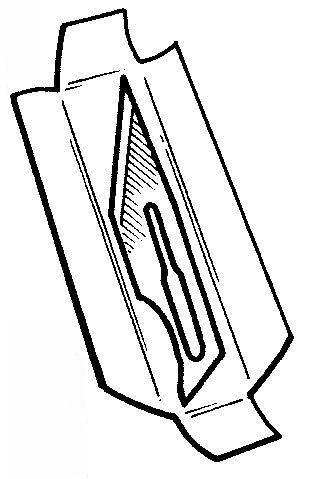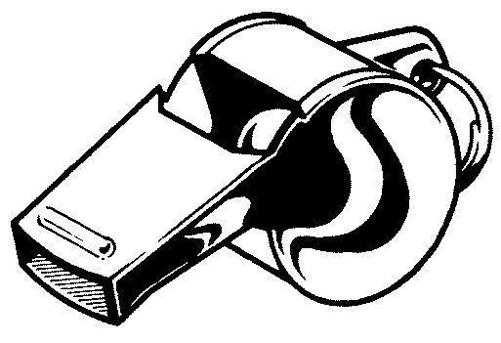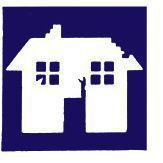Read SAS Urban Survival Handbook Online
Authors: John Wiseman
Tags: #Health & Fitness, #Reference, #Survival, #Fiction, #Safety, #Self-Help, #Personal & Practical Guides, #General, #Survival Skills
SAS Urban Survival Handbook (5 page)
Plasters

Scalpel blade

Tiny scissors

Whistle
Start with this as the standard kit and personalize it to suit YOUR needs and YOUR lifestyle. Cyclists and motorists could have their own versions. You may need a tiny screwdriver (especially if you wear glasses), antihistamine tablets (if you get hay fever), other medicines, tampons, condoms, a spare pair of contact lenses or eye drops, matches, breath fresheners, something to tie long hair back—you name it!
Keep the kit you carry small and easy to slip into a pocket or your handbag. If it becomes too bulky or inconvenient to carry, you will leave it at home on just the day you need it! It is like wearing a seat belt in a car. You wear it every time you drive—but the day you forget it is the day you have an accident! It is the same with your emergency kit. Carry it ALL THE TIME.
Safety first
You may think that you’re safe at home, but statistics indicate otherwise. The number of serious injuries and fatalities is staggering. Take steps to prevent yourself, your family and visitors from coming to harm.
SAFE AS HOUSES?
Structure • Subsidence & settlement • Outside checks • Inside checks • Damp/condensation • Rot/infestation • Asbestos risks • Repair priorities
ELECTRICITY
Know the enemy! • Electrocution • Earthing • Domestic supplies • Voltage • Power consumption • Replacing a fuse • RCDs/RCBs/ELCBs • Outdoor circuits • Low-voltage installations
GAS
Carbon monoxide • Gas leaks • Bottled/cylinder gas
LIQUID FUEL
Paraffin • Portable heaters
SOLID FUEL
WATER
Drinking water • Lead • Purification • Filtering water • Hard & soft water • Domestic water supply • Waste systems • Burst pipes • Tank floods
COMMON ACCIDENTS
Falls • Suffocation • Choking • Burns/scalds • Bleeding
ROOM CHECK
Kitchen—gas/electric/microwave ovens, fridges/freezers, food mixers, washing machines • Living room—fires, televisions/VDUs, children’s toys • Bedroom—electric blankets, nursery • Hallway/stairs/landing • Loft—access, insulation • Garden—pesticides, bonfires, electricity • Garage/shed—storage, tools, car repairs
LEAVING THE HOUSE
Out for the day • Going away
PETS
Safety & hygiene • Unusual pets
SAFE AS HOUSES?
 Most people think of the home as the one place where they can feel safe and secure—but statistics show that in industrialized societies there are as many accidents in the home as on the roads. In Britain alone, one person in 30 will have a serious accident in the home. Hospitals treat at least three million domestic injuries—and, since some result in visits to the doctor or self-help, the actual number of accidents may be much higher. Even in the garden, over 90,000 accidents are reported, ranging from slight to fatal.
Most people think of the home as the one place where they can feel safe and secure—but statistics show that in industrialized societies there are as many accidents in the home as on the roads. In Britain alone, one person in 30 will have a serious accident in the home. Hospitals treat at least three million domestic injuries—and, since some result in visits to the doctor or self-help, the actual number of accidents may be much higher. Even in the garden, over 90,000 accidents are reported, ranging from slight to fatal.
Types of accident
Everyone is at risk, but children and old people particularly so. The young are inquisitive and full of energy, while older people can quite often be handicapped by poor eyesight, bad hearing and slower reactions.
A quarter of a million British children require hospital treatment for accidents which result from the structure of the house itself—falling and head injuries from hard edges and corners of furniture.
Children at play around the home will have quite surprising accidents—most of which cannot be foreseen. Most hurt themselves by falling, tripping or slipping on a flat surface. Statistics are lower for falls from one level to another, such as out of a window. Next come injuries against objects such as the corners of tables, followed by cuts and deeper wounds, suffocation, poisoning and burns.
It’s up to you
People spend an average of 16 hours a day at home, so make sure yours is safe. Keep it properly maintained—put right any problems that increase risk. Make sure that you do not create new dangers as you make changes or improvements.
Most occupations and areas of work are covered by stringent safety laws. These should always be followed and it is not totally up to you to ensure that you are protected from injury. But in the home, safety is largely a matter of common sense and personal discretion.
There are rules and regulations regarding the structure itself, but these have changed over the years and older dwellings may (quite literally) be deathtraps. Correctly installed and maintained gas, electrical and other services should be safe—but wear and tear on these, added to the possibility of human error, could be lethal.
Surveyors will tell you if a structure is safe or not, but no one will come to your house to check for worn electrical flexes, loose stair carpets and slippery floors. You are unlikely to be arrested for not paying due attention to an old and weak ceiling which could collapse. It is up to YOU to judge these things for yourself or call in an expert when in doubt. Don’t wait for something to happen!
Many household accidents could be avoided with a better understanding of the risks involved—an increased awareness of dangers which could seriously affect the lives of the occupants of your home.
PLEASE NOTE
All EMERGENCY! and SAVE A LIFE ! panels are intended only to guide you through emergency procedures, and to avoid the need to search through the pages of this book in a crisis. More-detailed instructions appear in the HEALTH chapter. Learn the procedures BEFORE you need to use them.
THE STRUCTURE
 Keeping your house in good repair is not just a matter of maintaining market value. Damage, defects and decay could create a serious risk to life and limb. When you buy a house it is usually thoroughly inspected by a qualified surveyor, but no one can spot every potential problem, nor predict exactly how a building will behave as time passes and external conditions change.
Keeping your house in good repair is not just a matter of maintaining market value. Damage, defects and decay could create a serious risk to life and limb. When you buy a house it is usually thoroughly inspected by a qualified surveyor, but no one can spot every potential problem, nor predict exactly how a building will behave as time passes and external conditions change.
Every structure ‘settles’ throughout its lifetime. This settlement is caused by the sheer weight of materials used in the construction, but is also affected by changes in the use of the building—floors and walls are affected by heavy traffic and the positioning of unusually heavy furniture. This process can be accelerated by environmental and local conditions. If you are worried about the safety of your home, it would be worth seeking professional advice.
There are several ways in which the very location of your home may be a severe threat:
Vibration
Trains, heavy traffic, roadworks and even low-flying aircraft can progressively weaken the fabric of a building. If you can feel vibration—and it’s not uncommon to ‘hear things rattling’ as a train passes—then your home is under threat.
Numerous factors determine the seriousness of such vibration. If a building has been next to a railway for 75 years and shows no serious damage, it may never do so. However, the type or intensity of rail traffic may change over the years and new problems may develop. Expect problems in new buildings when local conditions change for the worse.
Bombs, other explosions and earthquakes may do great damage, although the real extent of it may not be visible.
Clay soils
The main problem with clay subsoils is that they expand when wet and contract when subjected to drought. Shrinkage can be substantial in dry seasons, causing foundations to sink. When a period of wet weather follows, the clay expands, eventually lifting the foundations back up again. This may not be too serious if the shrinkage and heave occur evenly under the house, but uneven movement can be disastrous. A leaking water pipe on one side of a structure would cause local swelling of the clay. More surprisingly, a large tree near a house will ‘drink’ up vast quantities of water, causing local shrinkage.
Obviously a leak in a pipe must be located and fixed, but dealing with trees is more difficult. Remedies range from cutting down the tree, to severe root pruning. Sometimes the remedy only makes matters worse. With the cause of the shrinkage removed, the clay takes on water and begins to heave. This process could take several years, but will cause damage. Always consult an expert.
REMEMBER
If you are planting a tree near a house, and you expect the tree to achieve any appreciable size, it should not be planted within 10 m (over 30 ft) of the foundations. Even when not on clay soils, the roots of a tree can cause havoc. Willow will target the slightest leak in a buried water or drainage pipe and could cause damage.
Chalky/sandy soils
In severe winters, chalky and sandy soils may be subject to ‘frost heave’. As they take on water and freeze, they expand—with enough power to lift foundations. This problem is fairly rare and mainly affects unheated buildings.
